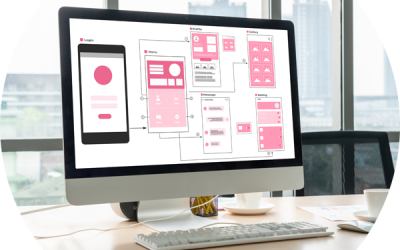The Software Dilemma: Balancing uniqueness, cost, and efficiency in business operations

From managing finances to streamlining processes, the right software can make or break a company’s efficiency and competitiveness. However, businesses increasingly face a critical dilemma: should they opt for off-the-shelf solutions or invest in bespoke software?
This decision is far from straightforward, with implications that reach into every corner of an organisation.

The pain point.
Many businesses find themselves caught between a rock and a hard place when it comes to software solutions. Off-the-shelf products offer quick implementation and standardised processes, but often force companies to alter their unique workflows – the very processes that may give them a competitive edge. Consider a small manufacturing company with a unique quality control process. Implementing a standard ERP (Enterprise Resource Planning) system might streamline some operations, but at the cost of compromising this distinctive approach.
The true cost of off-the-shelf solutions often exceeds the initial price tag.
Hidden expenses lurk in customisation attempts, training staff on new processes, and the ongoing struggle to make standardised software fit non-standard needs. As businesses grow, they may find themselves locked into escalating licence fees or forced to upgrade to more expensive tiers to access essential features.
However, off-the-shelf solutions aren’t without merit. They often come with immediate availability, regular updates, and a wealth of community support. For many businesses, especially those with standard processes or limited IT resources, these solutions can provide a cost-effective and efficient option.
The current landscape.
Recent trends in the software industry have added new wrinkles to this dilemma. Software as a Service (SaaS) inflation is outpacing consumer inflation, with a shocking 8.7% increase in 2023 alone. This means businesses are paying more each year just to maintain their current capabilities.
Even more concerning is the rise of ‘software shrinkflation’. Much like shrinking chocolate bars at the supermarket, some software providers are offering less functionality for the same price. This leaves businesses in a precarious position: pay more for the same service or accept reduced capabilities that may impact their operations.
These trends are hitting businesses where it hurts most – the bottom line. With one out of every eight pounds of corporate spending now going to software, companies are feeling the squeeze. The promise of reduced operational costs through digitisation is being eroded by ever-increasing software expenses.
Weighing the options.
In this challenging landscape, businesses must carefully consider their software choices. Both off-the-shelf and bespoke solutions have their place, depending on the specific needs and circumstances of the organisation. Let’s compare them:
| Aspect | Off-the-shelf | Bespoke |
|---|---|---|
| Implementation Speed | Quick | Longer development time |
| Initial Cost | Generally lower | Higher upfront investment |
| Long-term Cost | Ongoing licence fees, potential upgrades | Maintenance and updates as needed |
| Customisation | Limited, may require workarounds | Fully customisable |
| Scalability | May require tier upgrades | Can be designed for easy scaling |
| Updates and Support | Regular updates, community support | Depend on agreement with developer |
| Industry Compatibility | Often designed for industry standards | May require additional integration work |
| Unique Processes | May require process changes | Can be built around existing processes |
| Data Control | Often cloud-based, shared control | Can be fully controlled in-house |
Off-the-shelf solutions shine when speed of implementation is crucial, for standardised processes common across an industry, or when a business lacks resources for custom development.
Bespoke software, on the other hand, can be a compelling alternative when a business has unique processes that provide a competitive edge, when scalability and adaptability are crucial for future growth, when control over functionality and data is a top priority, or when the long-term cost-benefit analysis favours custom development.

Emerging Trends.
As technology evolves, new options are emerging that blur the lines between off-the-shelf and bespoke solutions:
- AI Integration
Both types of solutions are increasingly incorporating AI to enhance functionality and automate processes. - Low-Code/No-Code Platforms
These tools allow for greater customisation of off-the-shelf solutions without extensive coding knowledge.
- Microservices Architecture
This approach allows for more modular, customisable solutions that can be adapted over time. - Open Source Solutions
These provide a middle ground, offering customisation options with community support.

Conclusion.
As businesses navigate an increasingly complex digital landscape, the choice of software solutions becomes ever more critical. The key is to carefully assess your business needs, resources, and long-term goals. Consider the following steps:
- Audit your processes
Identify which processes are standard in your industry and which are unique to your business. - Assess your resources
Evaluate your budget, in-house IT capabilities, and timeline for implementation. - Consider future growth
Think about how your needs might change in the next 3-5 years.
- Analyse total cost of ownership
Look beyond initial costs to consider long-term expenses, including licences, upgrades, and maintenance. - Evaluate data control needs
Determine how much control you need over your data and functionality. - Explore hybrid options
Consider using off-the-shelf solutions for standard processes and bespoke software for core, unique operations.
Remember, there’s no one-size-fits-all answer. For some businesses, off-the-shelf products will offer the best balance of functionality and cost. For others, the investment in bespoke solutions will pay dividends in maintaining competitive advantage and operational efficiency.
Have you thoroughly assessed your software needs against your business processes and future goals? Whether off-the-shelf, bespoke, or a hybrid approach, the right solution can significantly impact your operations and competitiveness.
Take the time to explore all options and choose the path that best aligns with your unique business needs. Consider seeking expert advice to guide you through this crucial decision-making process.
Recent Posts
- The real cost of offshoring: Why UK companies are bringing software development back home
- Of heartstrings and algorithms: Music in the age of AI
- The heart-in-a-bucket problem: Why AI fails in organisations
- From a nudge to a sledgehammer: How AI’s gloves are off
- The hidden costs of poor UX: Why software interfaces matter more than you think


